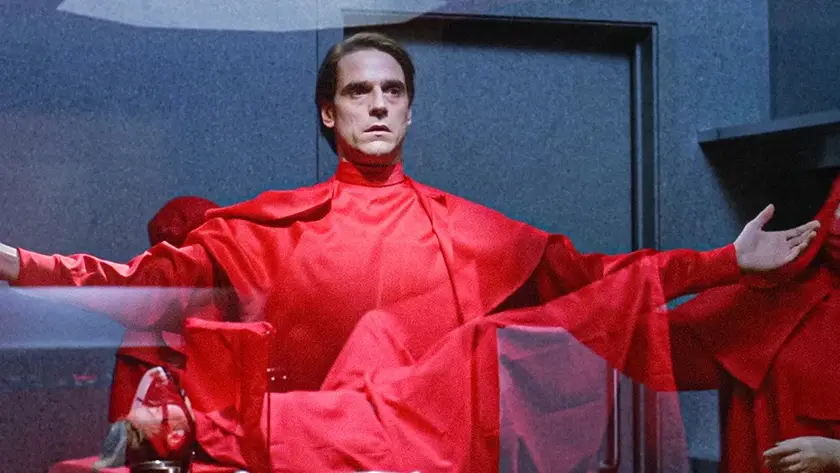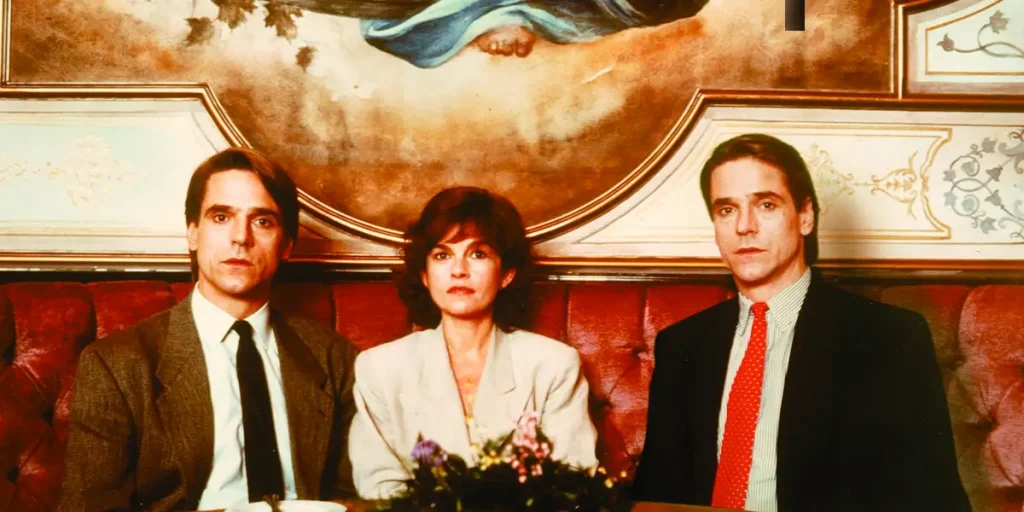Jeremy Irons delivers a masterclass dual performance in Dead Ringers, David Cronenberg’s odd psychological horror about codependent twin gynecologists.
Director: David Cronenberg
Genre: Psychological Thriller, Psychological Horror, Erotic Thriller
Run Time: 116′
Rated: R
U.S. Release: September 23, 1988
U.K. Release: January 6, 1989
Where to Watch: On digital & VOD
The late ’80s gifted us with numerous cinematic oddities (1989’s Society, anyone?), but few have maintained their unsettling grip quite like David Cronenberg’s Dead Ringers. Equal parts cult fascination and psychological curiosity, for better or for worse, the film’s legend precedes it. After the unexpected commercial success of The Fly in 1986, audiences might have expected another grotesque genre thrill ride from Cronenberg. The Canadian director was known for his shocking visuals. Instead, they received something far more clinical and disturbing: a harrowing two-hour spiral into psychosexual decay, medical detachment, and the emotional rot of codependency.
The premise alone sounds like high-concept horror bait. Identical twins Elliot and Beverly Mantle are brilliant fertility doctors running a successful clinic in Toronto. Both are played with eerie precision by Jeremy Irons (The Lion King). The twins have turned their physical indistinguishability into a grotesque con. Elliot, the confident alpha, seduces patients and passes them along to the sensitive, hesitant Beverly without the women ever knowing. Their shared identity isn’t just professional; it’s existential.
Then along comes Claire Niveau (Geneviève Bujold, Coma), a celebrated actress with a rare condition (a “trifurcated cervix”) that prevents her from conceiving. She becomes an emotional fault line that fractures the Mantle twins’ unnerving equilibrium. Beverly does the worst thing a codependent twin could do: he falls in love. Soon, everything begins to unravel. First, it’s through deceit, then addiction, then paranoid delusions involving “mutant women” and custom-built surgical tools that look like they belong in a medieval dungeon. As their carefully balanced dynamic implodes spectacularly, the twins must look within themselves for a cure to their madness.
By the time Dead Ringers arrived in 1988, Cronenberg had already carved out a lane as cinema’s resident surgeon of the psyche. He had peeled back skin and sanity with Videodrome, looked into the future in his haunting adaptation of Stephen King’s novel The Dead Zone, and made heads explode in his landmark movie, Scanners, in 1981. Dead Ringers could have taken things up a notch with a greater emphasis on body horror, dug deeper into the identity crises with the twins, and pushed the buttons on the queasy sexuality teased throughout, something Cronenberg would explore fully in 1996’s NC-17 rated Crash.
I can imagine the initial reaction from audiences. The cerebral film was released around the same time as Gorillas in the Mist and Elvira, Mistress of the Dark. All three couldn’t be more different in what they offer hungry viewers, but the level of engagement required for the strangeness of Dead Ringers can’t compare to that of a stirring biopic or a ribald comedy. Yet Dead Ringers comes off colder than you’d expect it to. There are no erupting pustules, no shifting flesh, no hunger for bones, no crawling insects. The real revulsion of the film is internal: a psychological horror show trapped in mirrored bodies that are physically separate but mentally twinned. That choice was daring for its time, but it makes for a strange and often distancing watch now. This is a movie for grown-up cinephiles; it doesn’t build to a blood-curdling scream but unspools slowly and methodically like tightly wound gauze until there’s nothing left.
The exception to any fragmentation you feel is, of course, Irons. His performance is the reason Dead Ringers still gets talked about. He embodies the twin gynecologists with such precision that distinguishing between them becomes genuinely challenging. Famously using the Alexander Technique (focusing on balance and posture), Irons creates distinctive “energy points” for each brother. Beverly and Elliot share identical features yet radiate completely different souls. Elliot is the confident manipulator, upright and grounded with a steady gaze, while Beverly carries himself with the trembling vulnerability of a collapsing star, shoulders slumped and hesitant. You know which twin you’re watching without being told. And sometimes, you’re not sure. Which is precisely the point.
Cronenberg uses our confusion to his advantage. He puts the viewer in the same disoriented state as Claire. It’s a dual performance so seamless that the visual trickery used to pull it off quickly fades into the background. You stop admiring the effect and start fearing the man—or men. This makes you complicit in pulling the wool over Claire’s eyes. The landmark technical wizardry that allowed Irons to converse with himself on screen isn’t showy. Shots of the twins together aren’t frequent, but when they appear, the effect is impressive for 1988. This early computer-controlled moving-matte photography never calls attention to its cleverness. The restraint is both intriguing and very Canadian in its modesty.
Unfortunately, nobody else in the film comes close to rising to the level of performance Irons is at from the first scene. Bujold, despite playing the woman who prompts the twins’ downward spiral, barely registers. It’s not entirely her fault. Cronenberg has never (and to this day) been great about writing for a female voice or from a female perspective. He and co-writer Norman Snider write Claire as if she’s stumbled in from a much less interesting film. Most characters are treated as clinical specimens rather than flesh-and-blood humans. However, Heidi von Palleske makes the most of her limited screen time as Elliot’s girlfriend, Cary. She’s particularly effective during a suggestively choreographed scene. In this sequence, she dances simultaneously with both brothers to The Five Satins’ “In the Still of the Night.”

Visually, Dead Ringers is often striking, with cinematographer Peter Suschitzky shooting Toronto as a sterile dreamscape in perpetual twilight. Indoors or outdoors, there’s a dark menace no matter what time of day. This marked his first collaboration with Cronenberg, and you can see the beginning of the visual language that would define the director’s next two decades. There’s an icy cleanliness to the film’s look, with blood-red surgical robes (one of the film’s most striking images) popping out like warning signs in an otherwise desaturated nightmare. Howard Shore’s haunting score punctuates key moments but disappears when you most expect it to crescendo. Sometimes, the silence works. Other times, it leaves scenes feeling barren.
The film’s aesthetic choices haven’t aged gracefully. Denise Cronenberg’s costume design captures the absolute worst of late-’80s fashion for women. Claire’s especially frumpy wardrobe suggests she’s wearing pieces from the Marilla Cuthbert of Green Gables collection. The schoolmarm couture mixed with a 1980s psychic look becomes unintentionally distracting. This is especially true when contrasted with Irons’ natty looks. Carol Spier’s production design features clashing pastels and unfortunate wood accents. Combined with the costume choices, these visual elements make Dead Ringers feel more dated than Cronenberg works made a decade earlier.
Cronenberg and Snider craft a narrative deliberately stripped of spectacle that frustrates expectations. This isn’t body horror in the traditional sense; there’s no grotesque transformation or alien parasite, though Cronenberg can’t resist including one stomach-churning moment best left for the curious to discover. Instead, the horror emerges from emotional parasitism, from two men so psychologically intertwined that individual identity becomes impossible. The film’s most chilling moments occur not in operating rooms but in quiet conversations where we witness the complete erosion of personal boundaries. Cronenberg’s direction opts for restraint. He explores how male dominance masquerades as medical concern, how love can curdle into obsession, and how identity dissolves when your mirror image shares your soul. Beverly spirals into drug addiction and paranoid delusions. He commissions bizarre surgical instruments that resemble medieval torture devices. The climax lands as a sad conclusion rather than a shocking twist.
Thematically, Dead Ringers has plenty to chew on with its ideas about intimacy warping identity, dependency mimicking disease, and male control over female bodies manifesting in clinical and violent ways. But the film never quite knows what to do with these musings, keeping the horror internal and almost entombed. That’s a tough sell when watching two men slowly dissolve into madness over two very deliberate hours. Maybe the problem is that Dead Ringers never scared me. As a kid, the VHS box haunted the shelf of my local video store as a title that I simply wasn’t old enough to see. I finally saw it decades later, and it turns out I could look away without feeling the pull to look back. Despite earning critical praise, sweeping the Genie Awards, and inspiring Rachel Weisz’s 2023 gender-flipped Amazon adaptation, the film reveals why initial audiences found it so alienating. This isn’t entertainment in any conventional sense; it’s an autopsy of masculinity performed without anesthesia.
Irons’ extraordinary performance anchors what could have been an unwatchable exercise in clinical detachment. His ability to create two distinct personalities within identical forms remains genuinely remarkable, a magic trick that deserved better material to showcase its brilliance. I’m honestly surprised it didn’t earn him an Oscar nomination, though that would arrive two years later with his win for Reversal of Fortune in 1990. Although the film succeeds as a character study, it falls short as compelling cinema, leaving viewers impressed by the work but emotionally detached. Dead Ringers represents Cronenberg operating at two extremes. On the one hand, this is one of his most intellectually rigorous outings, but on the other, it’s so emotionally remote that you need a compass to find your way to the credits. Overall, call it a fascinating misfire, an immaculate dissection with no pulse.
Dead Ringers: Movie Plot & Recap
Synopsis:
Twin gynecologists Elliot and Beverly Mantle share patients and lovers until actress Claire Niveau disrupts their codependent relationship, sending Beverly into a spiral of addiction and paranoia that threatens both their lives and careers.
Pros:
- Jeremy Irons’ tour-de-force dual performance
- Striking cinematography and dreamlike visual atmosphere
- Intelligent exploration of identity, codependency, and masculinity
- Seamless special effects that still hold up today
Cons:
- Deliberately paced and emotionally distant
- Dated costume and production design
- Underdeveloped supporting characters
- More intellectually engaging than emotionally compelling
Dead Ringers is now available to watch on digital and on demand.
Loud and Clear Reviews has an affiliate partnership with Apple, so we receive a share of the revenue from your purchase or streaming of the films when you click on some of the links on this page. This won’t affect how much you pay for them and helps us keep the site free for everyone.

